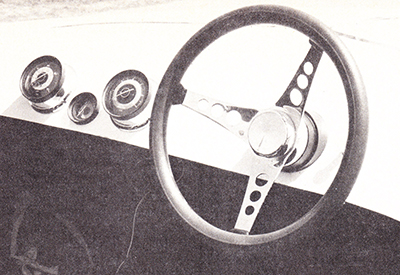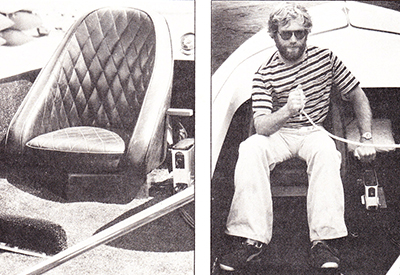J-Craft Ski-boat 19
By Andy Adams
Like the snow in winter and sun in summer, J- Crafts always seem to have been with us. But there has been a recent upsurge in popularity and these boats deserve a closer look.
The J’s were a big hit about 15 years ago when they joined the ranks of Rayson Crafts, Mandalas and other California-type ski-boats. With time the others have become just memories, but J-Crafts continue to grow in popularity and there are several good reasons why.
Our Test Bench subject was the Ski School model, so named because it was set up for ski-school use. The boat is a 19 footer with a short foredeck, long interior and rather spartan appointments. It is a specialist’s workboat and looks like it. There was nothing on the test boat that didn’t need to be there for ski use except the lettering and side-stripe. That means there was no wasted money spent or charged, and the boat was very well thought out.
Paul Roberts, the CNE’s delta kite flyer, had this boat set up for towing, so some of the credit should go to Paul for having it organized as it was, but J-Craft definitely learns and adapts. There will be no specific price given for this boat and motor combination in this test because at the pre-sent time there are still ongoing ing discussions about how it will be marketed this season.
This test boat will not necessarily be like the ones offered for sale. One change will be the seats, which apparently were too soft and comfy for rigorous ski-school use, so shell-type fibreglass buckets are contemplated.
 That’s understandable, but too bad because the seats were very plush and really locked you in. But this boat is built to a specific purpose and if the schools want plain seats they get them.
That’s understandable, but too bad because the seats were very plush and really locked you in. But this boat is built to a specific purpose and if the schools want plain seats they get them.
Also, the test boat had no windshield but future ones may because the cool breeze in the boat is not always appreciated by wet skiiers who have to put on a show come rain or shine. However, the new changes affect the Ski School J-Craft, the basic boat will not be altered.
It’s a success formula that works and shouldn’t be tampered with, and the formula is simple: take one relatively flat-bottomed boat that planes easily and is strong enough to carry any power you want, add heavy braces for the ski-tow pylon and seats, and sell it. That’s really about all there is to this boat. There are no swivelling drink-holders, teak appliqués, storage areas, glove boxes or other non-functional bits.
The basic hull is hand-laid fibreglass with end-grain balsa core that’s quite thick, very strong but not heavy. At 825 lbs the J is sturdy, but that’s featherweight for a 19-footer. There is no sub-floor, the bottom being quite flat enough to serve that duty, and the deck is bonded into the hull to give one-piece construction that has withstood all manner of foolish stunts and hard work. I’ve heard of J’s collecting other boats, docks, rocks, and even coming off the trailer at highway speed and surviv-ing. You won’t win any points at the factory for trying this sort of testing, but you can understand why people like this boat. It doesn’t let you down even when you deserve it.
The transom is well braced with the bonded deck and despite only having a tiny splash-well, the J-19 is rated for the biggest outboards.
 The hull itself is called a modified V type because, although it is vee’d, it is quite mild and has a maximum of 12° dead rise. A pair of keel fins gives the boat accurate tracking both at high speeds and when pulling a skier, and a tiny, flat-V shape molded into the bottom at the transom throws the prop and cavitation plate into clear water for better performance. The hull looks simple but it truly is the result of years of development.
The hull itself is called a modified V type because, although it is vee’d, it is quite mild and has a maximum of 12° dead rise. A pair of keel fins gives the boat accurate tracking both at high speeds and when pulling a skier, and a tiny, flat-V shape molded into the bottom at the transom throws the prop and cavitation plate into clear water for better performance. The hull looks simple but it truly is the result of years of development.
While on the subject of hull shape I should attempt to correct one misconception about J-Crafts. Although the hull is often described as a flat bottom, it really isn’ t. The V is nothing like many of the most recent boat s with 12° to 18° at the transom but this doesn’t mean the J-Craft has a rock-crusher ride. On big waves in the ocean or the Great Lakes a J will pound, but on the many smaller lakes and rivers in Quebec, Ontario, Manitoba, and Northern Michigan the waves are not as large or rolling. A brisk chop seems to be the norm in the se locations, and here the J’s bottom shape tends to bridge several waves at once, spreading the shock over quite a large area and actually giving a superior ride over many deeper Vs. The very rigid construction
helps too.
For skiing, the hull is great. It planes with almost no effort at all and easily plucks several skiers out of deep water for pyramids and other stunts. At trick speeds the J throws a crisp wake with a well-defined table for turnarounds, step overs and the like. As speed rises, the wake disappears to just a froth ideal for high- speed slalom runs and barefoot. Lastly. the hull shape won’t sink as a true deep-V does when speed drops. This boat is easy to plane and hold while slowing to reorganize a lost skier into the pyramid or for changing speeds when teaching.
At the CNE Ski Show the big V6 Johnson deserved a lot of credit. I’m not a big fan of large out-boards but this 175-hp engine is for skiing. With a 15x l9 SST three-blade OMC prop the boat was all pull. At any speed the engine would hold with no loss of revs or speed creep, and it was always ready to fly if you slammed the lever down. There was almost too much torque.
The Johnson would hit 43mph at 5,300 rpm in a wink. It was set up to pull at lower speeds, and my only criticism on performance was that it needed more prop and more speed to be tractable. This is a strange comment I know, but both engine and boat seemed to want to go faster than the 15xl9 prop would allow. The Johnson heaved the whole rig ahead with such force that it ran a somewhat snaking path over the waves and the steering was feeding back all sorts of twisting forces. There was just too much torque for the speeds.
Acceleration was great, as you would expect: 0 to planing speed in only 2.64 seconds; maximum with a piercing scream in 7.36 secs. I seriously doubt that even a couple of skiers would drop those times even marginally, and that’ s what a ski-boat is all
about. We weren’t able to run our fuel economy tests on the boat and engine. That type of prop and work wouldn’t be very economical, which isn’t to say that the rig set up for all around use would be a gas guzzler. It could even do fairly well because it is efficient, but the engine itself is geared and ported for torque. OMC recommends this 175 over the 235 for skiing and heavy cruisers. It’s the workhorse of the OMC line.
Actually, driving the J is quite pleasant. It was about the most responsive rig I’ve driven, handled predictably and in a sure footed manner at all but maximum, and steered and tracked very well. You never have to give the wheel a husky heave-ho because it doesn’t tighten up, and the boat doesn’t really need trimming. It’s always about right. Trimming is more important for all out speed than for skiing anyway; a remote water pickup and a transom jack could give incredible speeds if that’s what you’re after.
The J-Craft had black polypropylene carpeting throughout the interior, adding little weight but being serviceable and keeping skis and people from getting scratched. There are various seating combina-tions available with various J-Craft models. While the test boat had a single-seat wrap around buck-ets with one front facing and one rear facing, other back to back layouts are offered.
Actually most J’s are custom finished anyways. Things like Paul Roberts centre mounted gear and throttle box for kiting are quite common to the people at J-Craft, as are the pylons, heavy mounting plates and the plastic covered loop over the engine to prevent it from being fouled by tow-lines.
This boat is about as well suited to ski schools as any, but other J-Craft models are equally popular. Many are now being set up with stern drives, or smaller outboards which still work well on the 17 or 19, and yes, you can still get a hairy chested V8 and V-drive if you love inboards.
I’m sorry that prices weren’t out for this test because the J’s are extremely reasonable compared to other boats of this type, but you should be able to get into a ski-school boat for around $8,000 de-pending on your engine choice. With a Johnson 175 the tab might be a bit higher. but we’re talking about a well-built 19-ft sport boat and $8,000 (1979) is a bargain as far as I can see.
Originally published in Canadian Yachting April 1979 issue
Specifications:
Length: 18ft 9in
Beam: 80 in
Weight (hull only): 825 lbs
Engine: Johnson V6, 175hp
Photo Captions:
Photo 1 – J-Crafts were a big hit about 15 years ago and the continue to grow in popularity for many reasons.
Photo 2 – The simple dash layout is ample for the Johnson 175.
Photo 3 – Note throttle mans foot brace; J’s have various seating options.























